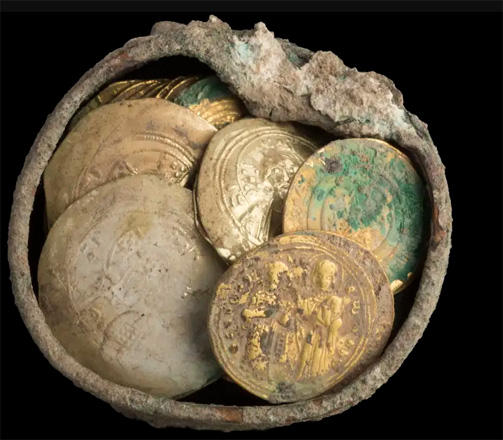A small bronze pot was found a few days ago at the Caesarea National Park, and inside it were 24 gold coins and a gold earring, according to the Antiquities Authority. The cache was found hidden between two stones in the side of a wall, located in a house in a neighborhood that dated from the Abbasid and Fatimid periods (909-1171 CE).
The coins are dated to the end of the 11th century, which would link the cache to the Crusader conquest of the city in the year 1101, one of the more critical events in the city’s medieval history.
According to the Antiquities Authority, most inhabitants of the city were massacred by Baldwin I’s army between 1100 to 1118 CE. Baldwin I served as the king of the Crusader kingdom of Jerusalem. The authority said it can be presumed that the treasure’s owner and his family likely died in the massacre or were sold into slavery. They would have been unable to return to the site of the cache and retrieve their hidden gold.
“The cache is of a unique combination of coins not yet seen in Israel consisting of two types of coins: 18 Fatimid dinars, well known from previous excavations in Caesarea, where it was the standard local currency of the time,” said Dr. Robert Kool, coin expert at the authority. “And a small and extremely rare group of six Byzantine imperial gold coins. Five of the coins are concave and belong to the reign of the Byzantine Emperor Michael VII Doukas (1071-1079 CE).”
Kool said that the coins did not circulate locally and may hint at trade relations between Caesarea and Constantinople during the time. One coin would be equal to a farmer’s annual salary, so whoever owned the cache was likely wealthy or involved in trade, Kool said.
The discovery was found in a location where two other treasures of the same period have been found. A golden pot that held silver jewelry was found there in the 1960s, and a collection of bronze vessels was found in the 1990s. Both finds are displayed at the Israel Museum in Jerusalem.
The multi-year Caesarea project is sponsored by the Edmond de Rothschild Foundation to the tune of NIS 150 million, in cooperation with the Caesarea Development Corp., the Antiquities Authority and the Israel Nature and Parks Authority.
















































